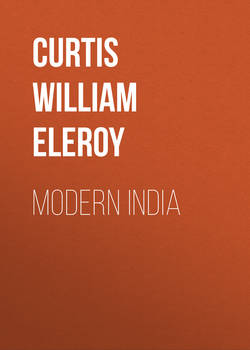Modern India

Реклама. ООО «ЛитРес», ИНН: 7719571260.
Оглавление
Curtis William Eleroy. Modern India
I. THE EYE OF INDIA
II. THE CITY OF BOMBAY
III. SERVANTS, HOTELS, AND CAVE TEMPLES
IV. THE EMPIRE OF INDIA
V. TWO HINDU WEDDINGS
VI. THE RELIGIONS OF INDIA
VII. HOW INDIA IS GOVERNED
VIII. THE RAILWAYS OF INDIA
IX. THE CITY OF AHMEDABAD
X. JEYPORE AND ITS MAHARAJA
XI. ABOUT SNAKES AND TIGERS
XII. THE RAJPUTS AND THEIR COUNTRY
XIII. THE ANCIENT MOGUL EMPIRE
XIV. THE ARCHITECTURE OF THE MOGULS
XV. THE MOST BEAUTIFUL OF BUILDINGS
XVI. THE QUAINT OLD CITY OF DELHI
XVII. THE TEMPLES AND TOMBS OF DELHI
XVIII. THUGS, FAKIRS, AND NAUTCH DANCERS
XIX. SIMLA AND THE PUNJAB
XX. FAMINES AND THEIR ANTIDOTES
XXI. THE FRONTIER QUESTION
XXII. THE ARMY IN INDIA
XXIII. MUTTRA, ALIGARH, LUCKNOW, CAWNPORE
XXIV. CASTE AND THE WOMEN OF INDIA
XXV. EDUCATION IN INDIA
XXVI. THE HIMALAYAS AND THE INVASION OF THIBET
XXVII. BENARES, THE SACRED CITY
XXVIII. AMERICAN MISSIONS IN INDIA
XXIX. COTTON, TEA, AND OPIUM
XXX. CALCUTTA, THE CAPITAL OF INDIA
INDEX
Отрывок из книги
A voyage to India nowadays is a continuous social event. The passengers compose a house party, being guests of the Steamship company for the time. The decks of the steamer are like broad verandas and are covered with comfortable chairs, in which the owners lounge about all day. Some of the more industrious women knit and embroider, and I saw one good mother with a basket full of mending, at which she was busily engaged at least three mornings. Others play cards upon folding tables or write letters with portfolios on their laps, and we had several artists who sketched the sky and sea, but the majority read novels and guide books, and gossiped. As birds of a feather flock together on the sea as well as on land, previous acquaintances and congenial new ones form little circles and cliques and entertain themselves and each other, and, after a day or two, move their chairs around so that they can be together. Americans and English do not mix as readily as you might expect, although there is nothing like coolness between them. It is only a natural restraint. They are accustomed to their ways, and we to ours, and it is natural for us to drift toward our own fellow countrymen.
It is customary for everybody to dress for dinner, and, while the practice has serious objections in stormy weather it is entirely permissible and comfortable during the long, warm nights on the Indian Ocean. The weather, however, was not nearly as warm as we expected to find it. We were four days on the Red Sea and six days on the Indian Ocean, and were entirely comfortable except for two days when the wind was so strong and kicked up so much water that the port-holes had to be closed, and it was very close and stuffy in the cabin. While the sun was hot there was always a cool breeze from one direction or another, and the captain told me it was customary during the winter season.
.....
The second thing that impresses you is the amount of glistening silver the working women wear upon their naked limbs. To drop into poetry, like Silas Wegg, they wear rings in their noses and rings on their toeses, and bands of silver wherever they can fasten them on their arms and legs and neck. They have bracelets, anklets, armlets, necklaces, and their noses as well as their ears are pierced for pendants. You wonder how a woman can eat, drink or sleep with a great big ornament hanging over her lips, and some of the earrings must weigh several ounces, for they fall almost to the shoulders. You will meet a dozen coolie women every block with two or three pounds of silver ornaments distributed over their persons, which represent their savings bank, for every spare rupee is invested in a ring, bracelet or a necklace, which, of course, does not pay interest, but can be disposed of for full value in case of an emergency. The workmanship is rude, but the designs are often pretty, and a collection of the silver ornaments worn by Hindu women would make an interesting exhibit for a museum. They are often a burden to them, particularly in hot weather, when they chafe and burn the flesh, and our Bombay friends tell us that in the summer the fountain basins, the hydrants and every other place where water can be found will be surrounded by women bathing the spots where the silver ornaments have seared the skin and cooling the metal, which is often so hot as to burn the fingers.
The race, the caste and often the province of a resident of India may be determined by his headgear. The Parsees wear tall fly-trap hats made of horse hair, with a top like a cow's foot; the Mohammedans wear the fez, and the Hindus the turban, and there are infinite varieties of turbans, both in the material used and in the manner in which they are put up. An old resident of India can usually tell where a man comes from by looking at his turban.
.....